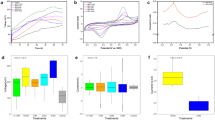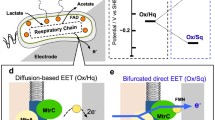Abstract
Escherichia coli K-12 was cultured under anaerobic conditions to form biofilm on carbon fiber electrodes in glucose-containing medium. The anodic current increased with the development of the biofilm and depended on the glucose concentration. Cyclic voltammetric results support the presence of a redox compound(s) excreted from E. coli cells in the biofilm. The compound remained in the film under conditions of continuous flow and gave a couple of oxidation and reduction waves, which may be assigned to a menaquinone-like compound based on the mid-point potential (−0.22 V vs Ag|AgCl at pH 7.1) and its pH dependence. The catalytic current started to increase around the anodic peak potential of the redox compound and also increased by the permeabilization of the E. coli cell membranes with ethylenediamine tetraacetic acid-treatment. The results indicate that the E. coli-excreted redox compound works as a mediator for the electron transfer from the E. coli cells to the electrode as the final electron acceptor. The activity of the redox compound in the E. coli-biofilm as a mediator with some mobility was also verified for diaphorase-catalyzed electrochemical oxidation of NADH.






Similar content being viewed by others

References
Angenent LT, Karim K, Al-Dahhan MH, Wrenn BA, Domiguez-Espinosa R (2004) Production of bioenergy and biochemicals from industrial and agricultural wastewater. Trends Biotechnol 22:477–485
Bentley R, Meganathan R (1982) Biosynthesis of vitamin K (Menaquinone) in bacteria. Microbiol Rev 46:241–280
Blattner FR, Plunkett III G, Bloch CA, Perna NT, Burland V, Riley M, Collado-Vides J, Glasner JD, Rode CK, Mayhew GF, Gregor J, Davis NW, Kirkpatrick HA, Goeden MA, Rose DJ, Mau B, Shao Y (1997) The complete genome sequence of Escherichia coli K-12. Science 277:1453–1474
Bullen RA, Arnot TC, Lakeman JB, Walsh FC (2006) Biofuel cells and their development. Biosens Bioelectron 21:2015–2045
Davis F, Higson SPT (2007) Biofuel cells—Recent advances and applications. Biosens Bioelectron 22:1224–1235
Friedheim E, Michaelis L (1931) Potentiometric study of pyocyanine. J Biol Chem 91:355–368
Gorby YA, Yanina S, McLean JS, Rosso KM, Moyles D, Dohnalkova A, Beveridge TJ, Chang IS, Kim BH, Kim KS, Culley DE, Reed SB, Romine MF, Saffarini DA, Hill EA, Shi L, Elias DA, Kennedy DW, Pinchuk G, Watamabe K, Ishii S, Logan B, Nealson KH, Fredrickson JK (2006) Electrically conductive bacterial nanowires produced by Shewanella oneidensis strain MR-1 and other microorganisms. Proc Nat Acad Sci USA 103:11358–11363
Gorton L, Domínguez E (2002) Electrocatalytic oxidation of NAD(P)H at mediator-modified electrodes. Rev Mol Biotechnol 82:371–392
Hanaki K, Chatsanguthai S, Matsuo T (1994) Characterization of accumulated biomass in anaerobic filter treating various types of substrates. Bioresour Technol 47:275–282
Hernandez ME, Newman DK (2001) Extracellular electron transfer. CMLS Cell Mol Life Sci 58:1562–1571
Ingledew WJ, Poole RK (1984) The respiratory chains of Escherichia coli. Microbiol Rev 48:222–271
Karube I, Matsunaga T, Tsuru S, Suzuki S (1977) Biochemical fuel cell utilizing immobilized cells of clostridium butyricum. Biotechnol Bioeng 19:1727–1733
Katz E, Shipway AN, Wilner I (2003) Biochemical fuel cells. In: Vielstich W, Gasteiger H A, Lamm A (eds) Handbook of fuel cells-fundamentals, technology, and applications, vol 1. Wiley, Chichester, pp 355–381
Kim HJ, Park HS, Hyun MS, Chang IS, Kim M, Kim BH (2002) A mediator-less microbial fuel cell using a metal reducing bacterium, Shewanella putrefaciens. Enzyme Microb Technol 30:145–152
Leive L (1965) A nonspecific increase in permeability in Escherichia coli produced by EDTA. Proc Nat Acad Sci USA 53:745–750
Logan BE, Regan JM (2006) Feature article: microbial fuel cells-challenges and applications. Environ Sci Technol 40:5172–5180
Lovley DR (2006) Bug juice: harvesting electricity with microorganisms. Nature 4:497–508
Martienssen M (2000) Simultaneous catalytic detoxification and biodegradation of organic peroxides during the biofilm process. Water Res 34:3917–3926
Matsunaga T, Namba Y, Nakajima T (1984) Electrochemical sterilization of microbial-cells. Bioelectrochem Bioenerg 13:393–400
Matsunaga T, Nakasono S, Takamuku T, Burgess JG, Nakamura N, Sode K (1992) Disinfection of drinking-water by using a novel electrochemical reactor employing carbon-cloth electrodes. Appl Environ Microbiol 58:686–689
Moiroux J, Elving PJ (1980) Mechanistic aspects of the electrochemical oxidation of dihydronicotinamide adenine dinucleotide (NADH). J Am Chem Soc 102:6533–6538
Newman DK, Kolter R (2000) A role for excreted quinones in extracellular electron transfer. Nature 405:94–97
Rabaey K, Verstraete W (2005) Microbial fuel cells: novel biotechnology for energy generation. Trends Biotechnol 23:291–298
Rabaey K, Boon N, Siciliano SD, Verhaege M, Verstraete W (2004) Biofuel cells select for microbial consortia that self-mediate electron transfer. Appl Environ Microbiol 70:5373–5382
Reguera G, McCarthy KD, Mehta T, Nicoll JS, Tuominen MT, Lovley DR (2005) Extracellular electron transfer via microbial nanowires. Nature 435:1098–1101
Schröder U, Niessen J, Scholz F (2003) A generation of microbial fuel cells with current outputs boosted by more than one order of magnitude. Angew Chem Int Ed 42:2880–2883
Sharma V, Meganathan R, Hudspeth MES (1993) Menaquinone (Vitamin K2) biosynthesis: cloning, nucleotide sequence, and expression of the menC gene from Escherichia coli. J Bacteriol 175:4917–4921
Takagi K, Kano K, Ikeda T (1998) Mediated bioelectrocatalysis based on NAD-related enzymes with reversible characteristics. J Electroanal Chem 445:209–217
Vostiar I, Ferapontova EE, Gorton L (2004) Electrical “wiring” of viable Gluconobacter oxydans cells with a flexible osmium-redox polyelectrolyte. Electrochem Commun 6:621–626
Wang YF, Cheng SS, Tsujimura S, Ikeda T, Kano K (2006) Escherichia coli-catalyzed bioelectrochemical oxidation of acetate in the presence of mediators. Bioelectrochemistry 69:74–81
Acknowledgements
This work was supported in part by Grants-in-Aids for Scientific Research from the Ministry of Education, Science, Sports and Culture of Japan (to S.T.), Centers of Excellence for Microbial-Process in Kyoto University (to K.K.), and the National Science Council of the Republic of China (No. NSC-95-2221-E006-288; to S.S.C.).
Author information
Authors and Affiliations
Corresponding author
Rights and permissions
About this article
Cite this article
Wang, YF., Tsujimura, S., Cheng, SS. et al. Self-excreted mediator from Escherichia coli K-12 for electron transfer to carbon electrodes. Appl Microbiol Biotechnol 76, 1439–1446 (2007). https://doi.org/10.1007/s00253-007-1114-6
Received:
Revised:
Accepted:
Published:
Issue Date:
DOI: https://doi.org/10.1007/s00253-007-1114-6



